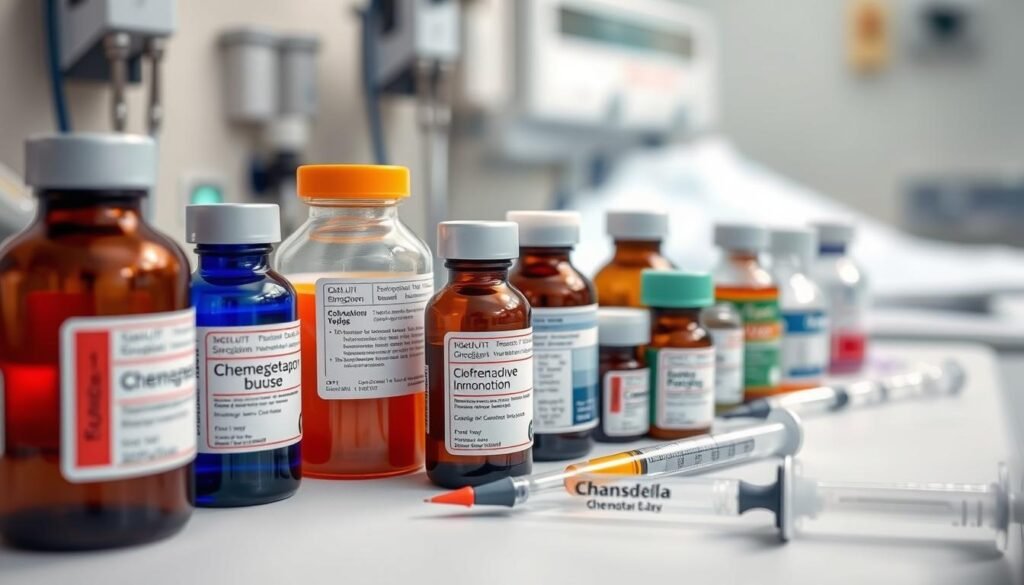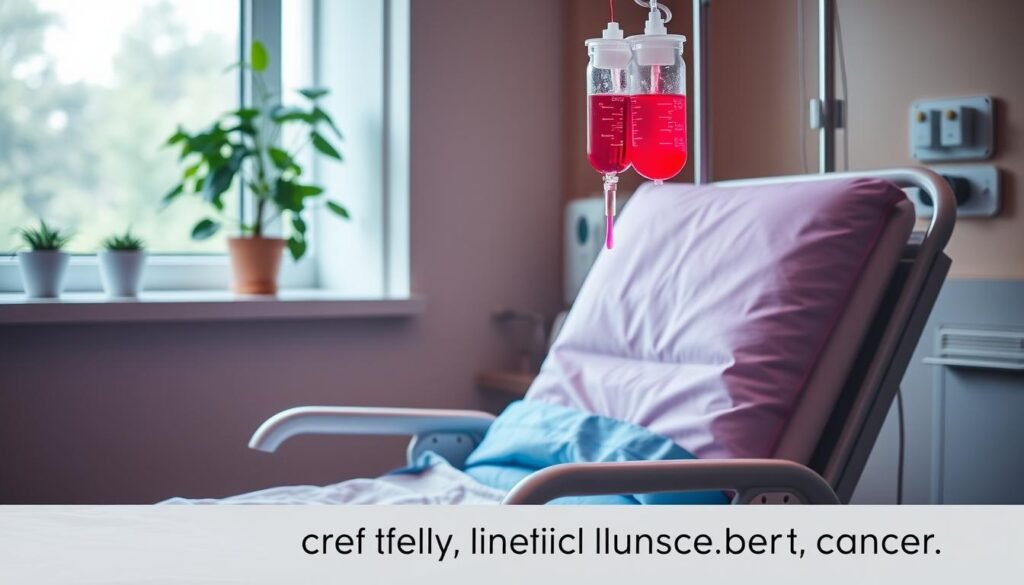Did you know chemotherapy is crucial in lung cancer care, despite new treatments? A notable response rate of 82.9% is seen when chemotherapy combines with targeted therapy. This shows how vital chemotherapy is for improving patient results. It proves its key role in lung cancer treatment strategies.
Chemotherapy is often the first treatment for lung cancer. It is used alone or with surgery or radiation. Before surgery, it can shrink tumors. After, it helps get rid of any cancer left. Treatment cycles usually last three to four weeks. It’s key to know how this affects survival and quality of life.
The quest for better treatments continues. Doctors are mixing chemotherapy with other treatments. This search offers hope for future care. So, knowing how well chemotherapy works in fighting lung cancer is key. It helps patients, carers, and doctors understand treatment options.
Key Takeaways
- Chemotherapy remains a cornerstone in lung cancer treatment, even when combined with newer therapies.
- The therapy is essential both before and after surgery to maximize patient outcomes.
- Response rates for chemotherapy demonstrate its significant effectiveness, especially in advanced stages.
- The treatment cycle typically lasts three to four weeks and may vary based on individual regimens.
- Understanding chemotherapy’s impact can help patients make informed decisions regarding their treatment plans.
Overview of Lung Cancer
Lung cancer is a major health issue, being a top cause of cancer deaths. It’s vital to know about the various types of lung cancer and their effects. This article talks about the different lung cancer categories and shares key facts on how often it occurs and how many lives it claims.
Types of Lung Cancer
Lung cancer splits into two groups: Small Cell Lung Cancer (SCLC) and Non-Small Cell Lung Cancer (NSCLC). SCLC quickly spreads and is very aggressive. On the other hand, NSCLC is more common and often leads to better outcomes if caught early. The choice of treatment, like surgery or chemotherapy, depends on the cancer’s stage and type.
Statistics on Lung Cancer Incidence and Mortality
Recent statistics on lung cancer are worrying. In 2023, the U.S. saw an estimated 238,340 new cases of lung cancer. About 126,799 people died from it. Worldwide, lung cancer causes around 1.8 million deaths each year, making it the deadliest cancer. These numbers stress the need for more research and better treatments.
| Type of Lung Cancer | Characteristics | Treatment Options |
|---|---|---|
| Small Cell Lung Cancer (SCLC) | Highly aggressive, spreads quickly | Chemotherapy, Radiation |
| Non-Small Cell Lung Cancer (NSCLC) | More common, grows slower | Surgery, Chemotherapy, Radiation |
Understanding Chemotherapy
Chemotherapy is key in battling lung cancer. It uses drugs to target and destroy fast-growing cancer cells. People often question what chemotherapy entails and its importance in treating cancer. Knowing this is crucial for anyone diagnosed with lung cancer.
What is Chemotherapy?
Chemotherapy treats cancer with specific drugs. These can be given through an IV or orally. It’s used alone or alongside surgery or radiation. For small cell lung cancer, it is very effective. The Lung Foundation Australia offers great support and information.
How Chemotherapy Works Against Lung Cancer
Chemotherapy attacks the cancer cells that grow and spread. It helps improve survival rates. When used early, especially with PD-L1 high cases, outcomes get much better.
Combining it with other treatments works even better. Treatment plans should be tailored to each person. Those in good health see better results with platinum-based chemotherapy. It’s a strong option for advanced lung cancer.
Effectiveness of Chemotherapy in Treating Lung Cancer
Chemotherapy is key in fighting lung cancer, leading to better health results. It shows its importance by improving treatment success.
Clinical Benefits of Chemotherapy
Chemotherapy brings many benefits to lung cancer patients. It improves life quality and helps people live longer. For instance, the CheckMate 816 trial showed encouraging results. Patients treated with nivolumab and chemotherapy together lived longer without their disease worsening. They had a median event-free survival of 31.6 months.
Those receiving only chemotherapy had 20.8 months. Moreover, 76.1% of patients in the combo treatment were free of adverse events after one year. This is much better than the 63.4% with chemotherapy alone.
Comparative Outcomes: Chemotherapy vs. Supportive Care
Chemotherapy compared to supportive care shows a big difference in patient survival. Patients with nivolumab and chemotherapy had a 63.8% two-year event-free survival rate. Supportive care didn’t do as well.
This highlights how chemotherapy can extend lives and improve outcomes for lung cancer patients. For the latest on lung cancer treatments, you can learn more here.
Types of Chemotherapy Drugs Used in Lung Cancer Treatment
Chemotherapy is key in treating lung cancer. Cisplatin and carboplatin are two important drugs for this. They are mainly used for non-small cell lung cancer (NSCLC). These can be used alone or with other drugs. This approach helps fight the disease more effectively.
Cisplatin and Carboplatin
Cisplatin is a platinum drug known for its effectiveness. It tends to work better than carboplatin but has more side effects. Carboplatin, on the other hand, is easier on patients. It’s preferred for those who might not handle harsh effects well.
They are often used with other drugs like pemetrexed or gemcitabine. This helps manage early-stage lung cancer better. It lets doctors create treatment plans that fit the patient’s needs.
New Generation Chemotherapeutic Agents
New drugs are showing promise for lung cancer patients. Pemetrexed and nanoparticle albumin-bound paclitaxel are two of them. They work well and are easier to tolerate. These advances offer more personalized treatment options.
With these new drugs, doctors can tackle the unique challenges each patient faces. The goal is to achieve the best possible outcomes.

Role of Chemotherapy in Combination Therapies
Chemotherapy plays a key role in mixed treatments for lung cancer. It helps improve how well these treatments work. The way doctors use chemotherapy has changed. Now, it’s used before or after surgery to get better results for patients.
Neoadjuvant and Adjuvant Chemotherapy
Neoadjuvant chemotherapy is given before surgery. It helps shrink the tumor, making it easier to take out. Then, adjuvant chemotherapy is used after surgery. It targets any cancer cells still left. This method helps stop the cancer from coming back.
Studies show that using both methods together really helps patients live longer. These combination therapies have changed the outlook for many people with lung cancer.
Chemotherapy with Targeted Therapy and Immunotherapy
Adding chemotherapy to targeted therapy and immunotherapy is opening new doors in lung cancer care. Trials show this mix improves results, especially for advanced cancer. For instance, adding immunotherapy to chemotherapy works really well against small cell lung cancer.
This approach often does better than using just one treatment. It’s giving new hope to patients facing this tough disease.
Chemotherapy for Small Cell Lung Cancer
Chemotherapy is key in treating small cell lung cancer because it responds well to it. The choice of treatment is important. It lets doctors create specific plans based on the cancer stage and how severe it is.
Standard Treatment Approaches
In limited-stage small cell lung cancer (SCLC), chemotherapy and radiation therapy are used together. This method is called chemoradiation. It attacks the cancer from all sides. For widespread SCLC, chemotherapy is the main treatment. It is sometimes combined with immunotherapy to work better.
- Common chemotherapy combinations for SCLC include:
- Cisplatin and etoposide
- Carboplatin and etoposide
- If the SCLC comes back or gets worse, doctors may use drugs like Topotecan, Lurbinectedin, or Docetaxel.
- Patients usually have 4 to 6 cycles of treatment. These involve getting medicine through a vein for several hours.
Impact on Patient Outcomes
Chemotherapy significantly helps people with small cell lung cancer. It can greatly improve how long they live. Sure, there are side effects like feeling sick, losing hair, and feeling tired. But, many believe the good from chemotherapy is worth these issues. The success of chemotherapy depends on if the cancer comes back after treatment.

| Treatment Stage | Common Treatments | Chemotherapy Outcomes |
|---|---|---|
| Limited-stage SCLC | Chemoradiation | Better chances of getting better and living longer |
| Extensive-stage SCLC | Chemotherapy with Immunotherapy | Better results with combined treatments |
Understanding SCLC treatment and its effects is vital. It shows why having chemotherapy plans made just for a patient is crucial. As the medical field grows, so do the ways to improve life for those with small cell lung cancer.
Chemotherapy for Non-Small Cell Lung Cancer
Non-small cell lung cancer (NSCLC) is the most common type of lung cancer. Treatment often starts with first-line chemotherapy. This important step uses drugs like cisplatin or pemetrexed to target cancer cells. Knowing how well treatments work and the role of ongoing therapy is key.
First-Line Treatments and Response Rates
First-line chemotherapy is crucial in treating NSCLC, especially for tumors with certain traits. Medicines such as cisplatin combined with pemetrexed are typical choices. The success of treatment depends on the tumor type and genetic aspects. For example, adenocarcinoma patients might have different results than those with squamous cell carcinoma. It’s important to tailor treatments based on these factors.
Maintenance Therapy Strategies
After initial chemotherapy success, maintenance therapy becomes vital. It lets patients use milder drugs to extend remission and life quality. Maintenance often includes targeted therapies for specific mutations or immunotherapies focusing on PD-L1 levels. Tailoring these strategies helps improve survival rates in various NSCLC cases.
Challenges and Considerations in Chemotherapy
Chemotherapy is key in treating lung cancer, but it brings challenges. Patients and healthcare providers must deal with its side effects. Knowing about these effects is crucial for the best lung cancer care.
Chemotherapy Side Effects
Chemotherapy side effects vary widely. Here are some common issues:
- Chemotherapy-induced nausea and vomiting (CINV), affecting up to 80% of patients.
- Fatigue, the most common side effect.
- Bowel habit changes, like diarrhea and constipation.
- Hair loss, usually starting within three weeks of treatment.
- Chemotherapy-induced peripheral neuropathy (CIPN) troubling hands and feet.
- A weakened immune system, raising infection risks.
Managing these side effects is key to improving life quality during treatment.
Factors Influencing Treatment Decisions
Many factors affect lung cancer treatment choices. These include:
- The patient’s overall health, which influences chemotherapy suitability.
- The tumor’s genetic traits, affecting treatment effectiveness.
- The cancer’s type and stage, crucial for planning treatment.
- The patient’s wishes and health goals for personalized care.
Oncologists consider these to tailor chemotherapy, weighing treatment benefits against side effects risks.

Understanding these factors helps in making informed lung cancer treatment decisions. These decisions are customized for each patient.
Emerging Treatments and Future Directions
The world of lung cancer treatment is changing fast. Experts are working hard on new, precise ways to help patients more. They’re bringing together different methods to find better routes for treatment.
Research on Combination Treatments
Right now, merging therapies play a big part in treating lung cancer. These methods mix different treatments to hit the cancer hard. They aim to work better together, causing fewer bad side effects. This includes using chemo, special targeted medicines, and immune boosters.
Scientists are busy figuring out the best mixes and orders of treatments. They want to find what’s most powerful for all types of lung cancer patients.
The Role of Clinical Trials
Clinical trials are key in making new lung cancer treatments. They let patients try the latest therapies not yet out for everyone. Being part of a trial helps gather info on how well treatments work and their safety.
This information is crucial. It helps figure out the best treatment plans, focusing on great results for patients.
Conclusion
Chemotherapy is key in treating lung cancer. It boosts survival rates and quality of life for patients. It’s especially crucial when no genetic changes are found. This shows old methods still work well against lung cancer.
Combining chemotherapy with new treatments is promising. As we learn more, mixing old and new therapies improves patient care. The way we treat lung cancer is quickly changing. This brings new hope and methods for fighting the disease.
The fight against lung cancer continues strongly. We’re always looking for better treatments through trials and research. For more on lung cancer therapy progress, check a study here.